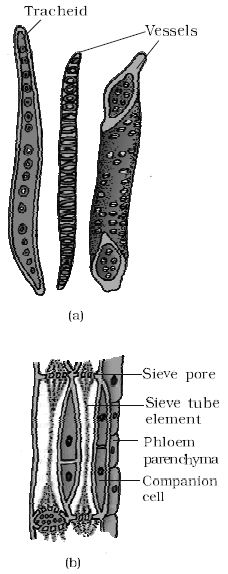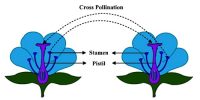The complex tissues are made of more than one type of cells and these works together as a unit. Xylem and phloem constitute the complex tissues in plants (Figure).

Fig: Xylem and Phloem
Xylem functions as a conducting tissue for water and minerals from roots to the stem and leaves. It also provides mechanical strength to the plant parts. It is composed of four different kinds of elements, namely. Tracheids, vessels, xylem fibers and xylem parenchyma.Gymnosperms lack vessels in their xylem. Tracheids are elongated or tube-like cells with thick and lignifled walls and tapering ends. These are dead and are without protoplasm. The inner layers of the cell walls have thickenings which vary in form. In flowering plants, tracheids and vessels are the main water transporting elements. A vessel is a long cylindrical tube-like structure made up of many cells called vessel members, each with lignified walls and a large central cavity. The vessel cells are also devoid of protoplasm. Vessel members are interconnected through perforations in their common walls. The presence of vessels is a characteristic feature of angiosperms.
Xylem fibers have highly thickened walls and obliterated central lumens. These may either be septate or aseptate. Xylem parenchyma cells are living and thinly walled. and their cell walls are made up of cellulose. They store food materials in the form of starch or fat and other substances like tannins. The radial conduction of water takes place by the ray parenchymatous cells.
Phloem transports food materials, usually from leaves to other parts of the plant. Phloem in angiosperms is composed of sieve tube elements, companion cells, phloem parenchyma and phloem fibers.













